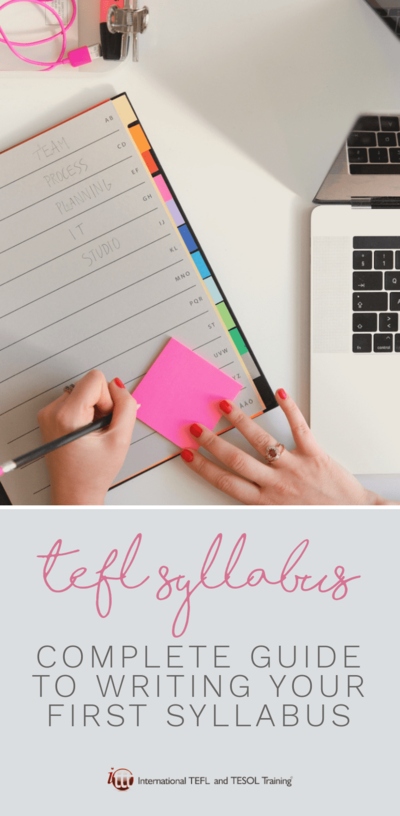Guide to Writing Your First TEFL Syllabus

So you've got your TEFL certificate in hand and landed your dream teaching job abroad. Once you're at the school, it's time to prep for your classes. More often than not, teachers are expected to create their own course syllabi for their different classes. Here is our guide to writing your first TEFL syllabus.
Table of Contents
What does my syllabus have to include?
Are you ready to teach English abroad?
This post was written by our ITTT graduate Zirui P.
What is a course syllabus?
The syllabus of a course is the frame of what the course is. It tells the students and the teacher what is being taught in the course as well as in what order it is being taught. This is especially true in language learning, as different types of syllabi will indicate what is being learned.There are many types of syllabi for language learning.
Depending on the focus of the course, the syllabus will generally be about six categories:
The structural/formal syllabus This type of traditional syllabus is generally used in regards to teaching grammar. This type of syllabus organizes the grammatical structures based on complexity, hence very helpful in teaching grammar, verb tenses, or parts of speech.
The notional/functional syllabusThis type acts similarly, with the exception that it is organized not by the grammatical structure but by the functions of expression. For example, expressions related to comparison may be grouped into the same lesson.
The situational syllabusThis syllabus type is based on specific situations and circumstances and the language needed for those sets. For example, a situational syllabus may include a lesson on making phone calls to book a dentist appointment.
The skill-based syllabus This type is centered on linguistic competencies/skills. This means that the lessons revolve around developing skills that are useful in the language such as reading, writing, speaking, and listening.
The task-based syllabusAs the name implies, this type of syllabus is based on activities and is task-driven. The lessons focus on language learning for the completion of a task. This type of syllabus allows for more hands-on utilization of the language.
The content-based syllabusThis syllabus is carried out in a similar way to taking a course in a foreign language. The student is simultaneously learning both new language and new information on the course subject (e.g. mathematics).

What does my syllabus have to include?
Although these standalone categories exist, it is often the case that syllabi created for classes include elements of multiple categories. The most important component in making the syllabus is to consider and adapt to the circumstances at hand. Therefore, one of the important questions is how to determine what is needed.
In determining what should need to be addressed in the course (beyond what is required by the employer), there are two steps that are helpful. The first one is a placement examination. Issuing a placement examination before the start of the course will help determine the proficiency of the students in terms of levels. This allows the teacher to grasp what information they already know and what they need to learn.
Furthermore, it will allow the teacher to prepare more accurate materials for the English level of the students so the lessons will not feel redundant. The second step is a needs analysis. This will gather information regarding what areas the students will need to know, how often they will use it, and even their previous experiences regarding the language. This allows for better planning of what the syllabus needs to incorporate as well as ideas for activities to be carried out within the individual lessons.
Also read: Top Online Lesson Plan Resources for New and Advanced Teachers

Writing your syllabus
In the actual writing of the syllabus, it is important to make sure that the syllabus tells the readers the basic outline of what they need to know. This may include: the lesson/unit title, test schedules, textbook chapters, what skill it teaches, and the lesson content (e.g. adjectives of comparison). This will allow the students to know what to expect and plan ahead. Similarly, it gives an outline for the teacher to follow and monitor the progress of the course.
How to time your syllabus
In terms of the time allowance for the course, such as individual class time and the lesson, numbers are often determined by the employer. Therefore, planning accordingly to fit the allocated time into your syllabus is important.
It is generally best to leave a day open at the beginning of the course for an introduction day where the teacher can also find the time to give out the necessary information for the course such as examinations, needs analysis, or even the syllabus. Similarly, it is also important to leave a few classes at the end of the course to give some time to review, give achievement/progress tests, and end of course evaluations. Depending on the class numbers, it sometimes may be necessary to allocate time for several progress tests based on how much material is covered between each test.
Also read: 10+ Activities For Teaching English Summer Camp
However, if it is a short course (e.g. 5-10 lessons, 1 hour each) it may only be necessary to conduct one final test. Similarly, if the course is very long (e.g. college semesters), it may be necessary to have both periodic progress tests, midterm exams, and final exams. But, once again, this is based on how much material is covered between each course. The time for the tests should also be indicated on the syllabus to allow for proper expectation and preparation.
As for the end of course evaluation, it is a tool for future course planning revision based on the insight and advice of the students who took the course. In planning individual courses, it may be helpful to list the main points and dedicate an individual lesson or lessons to them afterward by emphasizing some topics (adding more lessons) or cutting down on some other topics based on requirement (i.e. employer, needs analysis, diagnostic exams, etc.). In these stages, it becomes necessary to think about the grammar, vocabulary, and the actual language to be taught in them.
Listen to this blog post
Are you ready to teach English abroad?
In syllabus designing, there are many details to be paid attention to. From the structural format to the lesson content and from writing the lesson titles to planning textbook chapters, everything needs to be carefully considered before a final draft is born. A good syllabus can help not only with the course progress from the teacher's point of view but also allow students to prepare and expect what is to come and what they will be/are learning. The syllabus is a very important and useful tool in teaching.
Apply now & get certified to teach english abroad!
Speak with an ITTT advisor today to put together your personal plan for teaching English abroad.
Send us an email or call us toll-free at 1-800-490-0531 to speak with an ITTT advisor today.
Related Articles:
- Why You Should Take Specialized TEFL Courses
- The 5 Best Ways to Build Rapport With Your TEFL Students
- The Best Apps to Have on Your Phone While Teaching English Abroad
- 7 Steps to Paying Off Your Student Loans While Teaching English Abroad
- 5 Reasons Why Teaching English Abroad Enhances Your Career Prospects
- Two Traveling Teachers Share What It's Like Teaching English Abroad as a Couple




